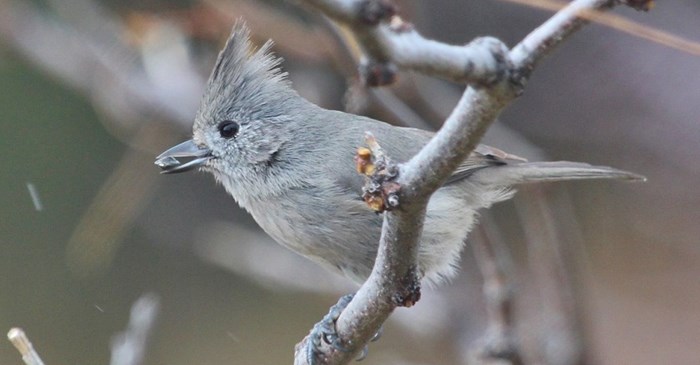With its tufted head and cute, wide-eyed look, the Juniper Titmouse may make you think of a younger relative of the Blue Jay, rendered in grayscale. Despite their plainness, these outgoing, spirited birds are a delight for feeder-watchers.
The Juniper Titmouse can be found throughout the pinyon and juniper woodlands of the West, especially Utah and Nevada, as well as western Colorado, eastern California, and upper New Mexico and Arizona. Look for this strong, acrobatic bird, hanging upside-down from tree branches. A technique they use to reach food in tough-to-reach places other birds can’t get to.
The song of the Juniper Titmouse sounds softer and scratchier than the clear-whistled “Peter-Peter-Peter” of the Tufted Titmouse. In fact, some liken the Juniper’s song to a video game. Their calls are urgent and scratchy, but they help them keep tabs on each other while foraging with their mates and flocks on the outer branches of trees and shrubs.
They're out and about year-round, since they don't migrate. The time of year they're most conspicuous is from from mid-March until May, where early in the morning they may be found singing from an exposed branch. Take time to know their calls and songs, and they’ll be easier to locate when you’re hiking through the woods.
The Juniper Titmouse gets its name from its preferred nesting place, the juniper tree. It's appearance is very similar to that of the Oak Titmouse. In fact, until 1997, these two birds were both known one species, the Plain Titmouse. But scientists determined since these groups of birds not only lived in very different habitats, they had enough genetic differences to separate them into two species.
Like other titmice species, the Juniper Titmouse nests in a crevice formed in the tree. They'll also choose nesting boxes, so to attract a pair to your backyard, be sure and set it up very early in the spring.
Juniper Titmice mate for life; if they don’t return to reuse a nesting site, chances are a different pair will. When incubating, the female will hold her ground in the face of a threat. She may even hiss like a snake!
In the winter, because they don't migrate, they supplement their insect-based diet by storing seeds in tree crevices and other places. They also favor pinyon nuts, and if your bird feeder is stocked with sunflower seeds and other morsels found in Lyric Chickadee Mix, you can be sure you’ll draw them by the flock. Then, watch as the Juniper Titmouse takes up its prize, hammers it against a tree branch or other hard surface, and cracks open the shell!
